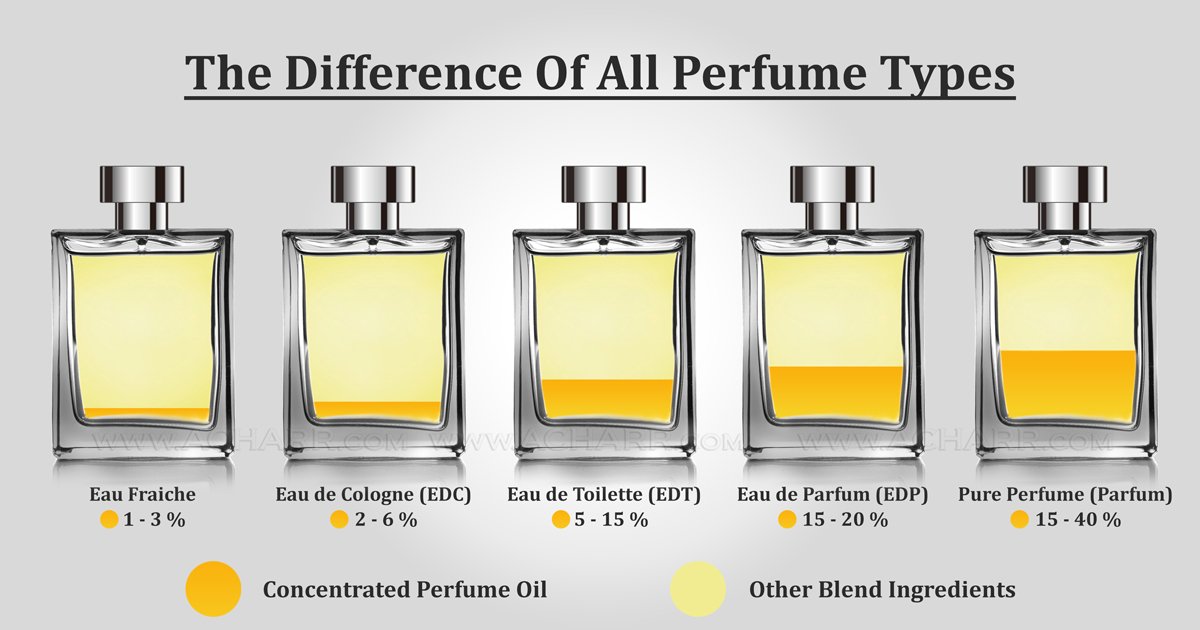Choosing a fragrance (EDT, EDP, Parfum) can be a daunting decision. Whether you’re adding to your fragrance wardrobe or selecting a new signature scent, there is much to consider on your search. When exploring fragrances, we’re typically looking for a scent that embodies our true colours and can adapt to various occasions and seasons – something that feels uniquely ‘you’. During this search, it can be helpful to understand the different types of perfume and which situations and preferences they may be best suited to. Read on for our guide to the difference between eau de toilette, eau de parfum and parfum to help you discover your ideal fragrance.
EDT vs EDP vs Parfum: What’s the difference?
When shopping for perfume, you might have encountered phrases like eau de toilette (EDT), eau de parfum (EDP), and parfum. Each of these fragrance types denotes a particular concentration of fragrance oil – and therefore intensity. These differences impact how long perfume lasts and how perfume smells when first applied. Here are the key distinguishing factors:
- Concentration level of fragrance oil: One of the primary differences between EDP, EDT and parfum is the concentration of perfume oils in each type. Parfum has the highest concentration with up to 40%, while EDP has a concentration of 15-20% and EDT contains 5-15% perfume oil. This effects the fragrance’s longevity.
- Scent profiles: Another difference between these perfume types is the character of the scent itself. When compared to EDP vs EDT, parfum usually has a richer and more complex scent profile. This is because the higher concentration of perfume oils in parfum allows for more intensity and depth.

What is a parfum?

Parfum, also known as ‘extrait de parfum’, is the most concentrated fragrance type in the world of perfumery. When comparing EDT vs EDP vs parfum, this type contains 20%-40% fragrance oils, making it an intense and long-wearing choice. Due to its robust features, this fragrance is ideal for formal occasions such as evening events when you need your scent to last for hours. Parfum is also suited to colder weather, as it has the ability to stand out beneath layers of winter clothing.
A parfum lends itself to deeper and more complex scents, like the Nishane Hacivat Extrait de Parfum. Offering a captivating fragrance experience, this intense take on our signature Black Opium range enhances the iconic coffee and floral notes in a new and distinctive way, leaving a lasting, elegant impression after each use.
What is an eau de parfum (EDP)?
If you’re curious about the difference between eau de toilette and eau de parfum, eau de parfum contains a higher concentration of fragrance oils – approximately 15%-20% in each bottle. It’s distinguished by its scent profile and longevity, lasting up to 10 hours on the skin with correct perfume application techniques.
A middle ground between parfum and eau de toilette, this perfume type pairs well with special occasions and is versatile enough for everyday use. Take our signature Mancera Cedrat Boise EDP as an example – with a balance of black coffee and white flower notes, this fragrance imparts an charismatic statement without being overpowering.
What is an eau de toilette?
Eau de toilette is a lighter and less concentrated fragrance type, with a lower composition of perfume oils (8%-15%) and a higher content of alcohol and water. The higher quantity of alcohol causes the fragrance to evaporate more quickly. Rather than being a drawback, this makes eau de toilette an ideal choice for day-to-day, or for reapplication on the go.
When it comes to EDT vs EDP, eau de toilette tends to adopt fresh and uplifting scent profiles, creating a relaxed aura for the wearer. For example, the light floral and citrus fragrance of the John Varvatos Artisan Pure, and the woody and musk freshness of Y Eau de Toilette are compelling for warmer days and informal occasions.
Which type of perfume to choose
To deepen and add to your knowledge of the difference between eau de parfum, eau de toilette and parfum, there are other important factors to consider when choosing a fragrance:
Personal preference
Fragrances should reflect your personal style and taste and identifying your preferred perfume scent profile can help to narrow down your search. Do you prefer floral, citrus, woody or oriental scents? What would you like to communicate about yourself via your signature fragrance?
Occasions and seasonality
Your perception of various scents can change depending on the occasions and seasons. Some fragrances are best suited to formal occasions like dinners, weddings, and work events, while others are perfect for a casual meeting with friends. Take into consideration the type of events you typically attend or the season you’re planning to wear the perfume to make an informed and well-rounded choice.
Skin chemistry
Fragrances react differently to different skin types, so it’s best to test fragrance on your skin when you can. When it comes to online shopping, our Try It First service allows you to try a complimentary 1.2ml sample of your chosen Libre Eau de Parfum Intense or Black Opium Eau de Parfum, so you can judge how a scent reacts with your personal skin chemistry before committing.
Found our guide to EDP vs EDT vs parfum helpful? Next, discover tips on which Libre perfume is right for you.

